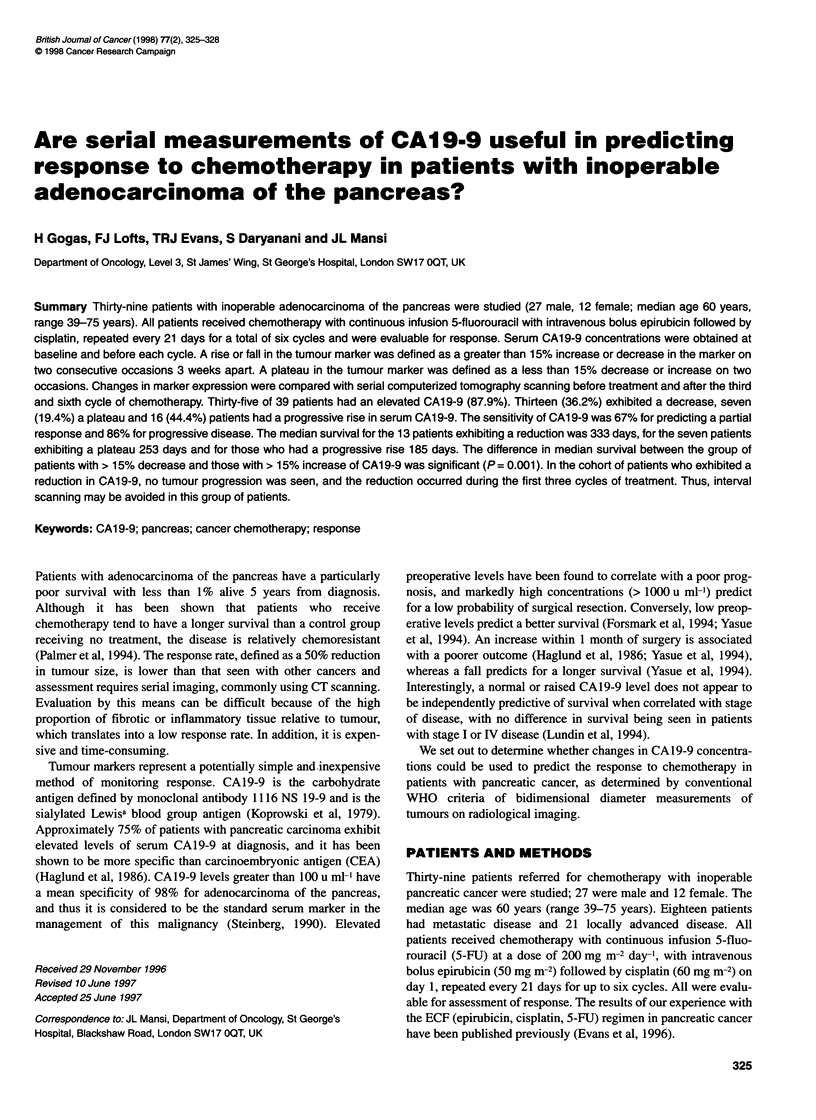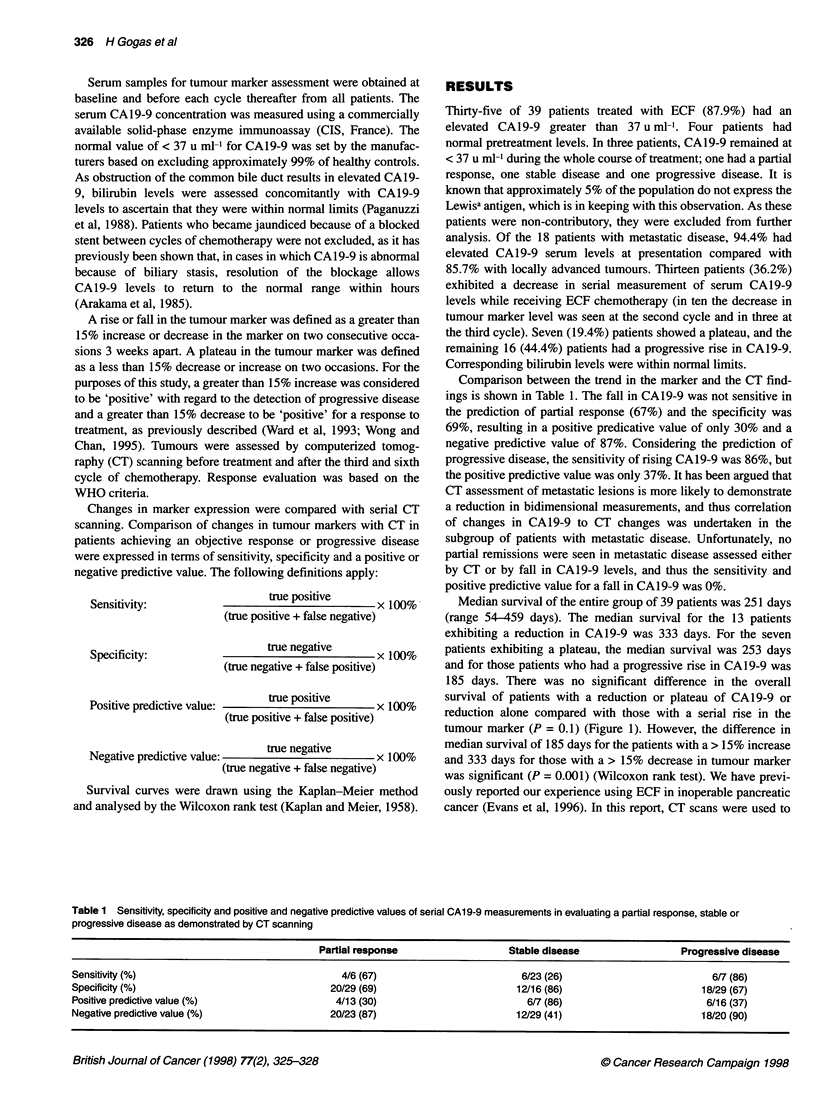Abstract
Thirty-nine patients with inoperable adenocarcinoma of the pancreas were studied (27 male, 12 female; median age 60 years, range 39-75 years). All patients received chemotherapy with continuous infusion 5-fluorouracil with intravenous bolus epirubicin followed by cisplatin, repeated every 21 days for a total of six cycles and were evaluable for response. Serum CA19-9 concentrations were obtained at baseline and before each cycle. A rise or fall in the tumour marker was defined as a greater than 15% increase or decrease in the marker on two consecutive occasions 3 weeks apart. A plateau in the tumour marker was defined as a less than 15% decrease or increase on two occasions. Changes in marker expression were compared with serial computerized tomography scanning before treatment and after the third and sixth cycle of chemotherapy. Thirty-five of 39 patients had an elevated CA19-9 (87.9%). Thirteen (36.2%) exhibited a decrease, seven (19.4%) a plateau and 16 (44.4%) patients had a progressive rise in serum CA19-9. The sensitivity of CA19-9 was 67% for predicting a partial response and 86% for progressive disease. The median survival for the 13 patients exhibiting a reduction was 333 days, for the seven patients exhibiting a plateau 253 days and for those who had a progressive rise 185 days. The difference in median survival between the group of patients with > 15% decrease and those with > 15% increase of CA19-9 was significant (P = 0.001). In the cohort of patients who exhibited a reduction in CA19-9, no tumour progression was seen, and the reduction occurred during the first three cycles of treatment. Thus, interval scanning may be avoided in this group of patients.
Full text
PDF



Selected References
These references are in PubMed. This may not be the complete list of references from this article.
- Arakawa Y., Ariga H., Kano M., Matsuo Y., Honda T., Morita K. Determination and significance of a new carbohydrate antigen CA19-9 in digestive system cancers. Jpn J Med. 1985 May;24(2):121–130. doi: 10.2169/internalmedicine1962.24.121. [DOI] [PubMed] [Google Scholar]
- Beastall G. H., Cook B., Rustin G. J., Jennings J. A review of the role of established tumour markers. Ann Clin Biochem. 1991 Jan;28(Pt 1):5–18. doi: 10.1177/000456329102800102. [DOI] [PubMed] [Google Scholar]
- Carmichael J., Fink U., Russell R. C., Spittle M. F., Harris A. L., Spiessi G., Blatter J. Phase II study of gemcitabine in patients with advanced pancreatic cancer. Br J Cancer. 1996 Jan;73(1):101–105. doi: 10.1038/bjc.1996.18. [DOI] [PMC free article] [PubMed] [Google Scholar]
- Evans T. R., Lofts F. J., Mansi J. L., Glees J. P., Dalgleish A. G., Knight M. J. A phase II study of continuous-infusion 5-fluorouracil with cisplatin and epirubicin in inoperable pancreatic cancer. Br J Cancer. 1996 May;73(10):1260–1264. doi: 10.1038/bjc.1996.241. [DOI] [PMC free article] [PubMed] [Google Scholar]
- Forsmark C. E., Lambiase L., Vogel S. B. Diagnosis of pancreatic cancer and prediction of unresectability using the tumor-associated antigen CA19-9. Pancreas. 1994 Nov;9(6):731–734. doi: 10.1097/00006676-199411000-00010. [DOI] [PubMed] [Google Scholar]
- Haglund C., Roberts P. J., Kuusela P., Scheinin T. M., Mäkelä O., Jalanko H. Evaluation of CA 19-9 as a serum tumour marker in pancreatic cancer. Br J Cancer. 1986 Feb;53(2):197–202. doi: 10.1038/bjc.1986.35. [DOI] [PMC free article] [PubMed] [Google Scholar]
- Koprowski H., Steplewski Z., Mitchell K., Herlyn M., Herlyn D., Fuhrer P. Colorectal carcinoma antigens detected by hybridoma antibodies. Somatic Cell Genet. 1979 Nov;5(6):957–971. doi: 10.1007/BF01542654. [DOI] [PubMed] [Google Scholar]
- Lundin J., Roberts P. J., Kuusela P., Haglund C. The prognostic value of preoperative serum levels of CA 19-9 and CEA in patients with pancreatic cancer. Br J Cancer. 1994 Mar;69(3):515–519. doi: 10.1038/bjc.1994.93. [DOI] [PMC free article] [PubMed] [Google Scholar]
- Marsh R. W., Manyam V., Bewsher C., Youngblood M. Circadian rhythm modulated 5-FUdR infusion with Megace in the treatment of advanced pancreatic cancer. J Surg Oncol. 1994 Sep;57(1):25–29. doi: 10.1002/jso.2930570108. [DOI] [PubMed] [Google Scholar]
- Paganuzzi M., Onetto M., Marroni P., Barone D., Conio M., Aste H., Pugliese V. CA 19-9 and CA 50 in benign and malignant pancreatic and biliary diseases. Cancer. 1988 May 15;61(10):2100–2108. doi: 10.1002/1097-0142(19880515)61:10<2100::aid-cncr2820611028>3.0.co;2-z. [DOI] [PubMed] [Google Scholar]
- Palmer K. R., Kerr M., Knowles G., Cull A., Carter D. C., Leonard R. C. Chemotherapy prolongs survival in inoperable pancreatic carcinoma. Br J Surg. 1994 Jun;81(6):882–885. doi: 10.1002/bjs.1800810629. [DOI] [PubMed] [Google Scholar]
- Philip P. A., Carmichael J., Tonkin K., Buamah P. K., Britton J., Dowsett M., Harris A. L. Hormonal treatment of pancreatic carcinoma: a phase II study of LHRH agonist goserelin plus hydrocortisone. Br J Cancer. 1993 Feb;67(2):379–382. doi: 10.1038/bjc.1993.69. [DOI] [PMC free article] [PubMed] [Google Scholar]
- Schifeling D. J., Konski A. A., Howard J. M., Dobelbower R. R., Jr, Merrick H. W., 3rd, Skeel R. T. Radiation therapy and 5-fluorouracil modulated by leucovorin for adenocarcinoma of the pancreas. A phase I study. Int J Pancreatol. 1992 Dec;12(3):239–243. doi: 10.1007/BF02924363. [DOI] [PubMed] [Google Scholar]
- Steinberg W. The clinical utility of the CA 19-9 tumor-associated antigen. Am J Gastroenterol. 1990 Apr;85(4):350–355. [PubMed] [Google Scholar]
- Ward U., Primrose J. N., Finan P. J., Perren T. J., Selby P., Purves D. A., Cooper E. H. The use of tumour markers CEA, CA-195 and CA-242 in evaluating the response to chemotherapy in patients with advanced colorectal cancer. Br J Cancer. 1993 May;67(5):1132–1135. doi: 10.1038/bjc.1993.208. [DOI] [PMC free article] [PubMed] [Google Scholar]
- Willett C. G., Daly W. J., Warshaw A. L. CA 19-9 is an index of response to neoadjunctive chemoradiation therapy in pancreatic cancer. Am J Surg. 1996 Oct;172(4):350–352. doi: 10.1016/S0002-9610(97)89547-5. [DOI] [PubMed] [Google Scholar]
- Wong A., Chan A. The use of the tumour marker CA19-9 in evaluating the response to tamoxifen therapy in patients with unresectable adenocarcinoma of the pancreas. Eur J Cancer. 1995 Nov;31A(12):2118–2119. doi: 10.1016/0959-8049(95)00413-0. [DOI] [PubMed] [Google Scholar]
- Yasue M., Sakamoto J., Teramukai S., Morimoto T., Yasui K., Kuno N., Kurimoto K., Ohashi Y. Prognostic values of preoperative and postoperative CEA and CA19.9 levels in pancreatic cancer. Pancreas. 1994 Nov;9(6):735–740. doi: 10.1097/00006676-199411000-00011. [DOI] [PubMed] [Google Scholar]


